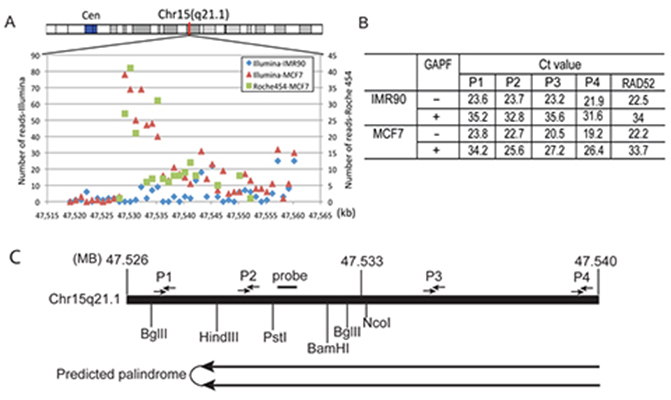Editor's note: Platinum Highlight articles are noteworthy publications selected periodically by Dr. Craig Reynolds, associate director, National Cancer Institute, from among the most recently published Platinum Publications.![]()
When Alison Rattray and colleagues in the Gene Regulation and Chromosome Biology Laboratory (GRCBL) examined a mutant yeast cell they had isolated in a screen, they noticed something strange.
The DNA exhibited a “very specific, but weird, rearrangement,” she explained. The arrangement turned out to be a DNA palindrome, “opening the door to studying these elusive DNA motifs,” she said.
A staff scientist in GRCBL, NCI Center for Cancer Research, Rattray said that, while their discovery occurred a number of years ago, their group continues to study DNA repair and rearrangements that result in abnormal repair “because of the association with certain cancers.” The group’s goal is to better understand the origin of these rearrangements, she added.
Rattray is a major contributor to research reported in BMC Genomics that describes the group’s newly developed method for genome-wide sequencing of DNA palindromes in a cancer cell line.
What Is a DNA Palindrome?
A palindromic sequence of nucleotides (which are labeled A, T, C, or G) occurs when complementary strands of DNA read the same in both directions, either from the 5-prime end or the 3-prime end. For example, the sequence GGATCC on one strand of DNA is considered a palindrome because the sequence on its complementary strand is CCTAGG.
Because of the sequence complementarity, palindromic sequences can also fold back onto themselves, forming hairpin loops or cruciforms that are extruded from the normal double helix, Rattray said. “Small hairpins are not problematic, but when palindromes are long (more than 100 base pairs), they interfere with normal cellular processes such as transcription and replication,” she explained.
Some cancer cells exhibit massive genome rearrangements, which include gene amplifications, translocations, and deletions, and these rearrangements are often associated with the presence of a palindrome, suggesting a possible correlation between the palindrome and the gene rearrangements. How these events arise is not well understood. What is known, however, is that such rearrangements are associated with the progression and prognosis of the cancer, Rattray said.
New Hypothesis for Genomic Rearrangement
According to Rattray, the favored model, originally proposed more than 60 years ago by Barbara McClintock, Ph.D., suggests that, following a chromosome break, sister chromatids replicate and fuse, creating a chromosome with two centromeres joined by a DNA palindrome. In the McClintock model, having two centromeres leads to further genomic rearrangements.
However, Rattray said that her group and others have shown that “DNA palindromes are unstable and can lead to genome rearrangements by themselves, further suggesting palindromes could arise not only by sister chromatid fusion, but also by other mechanisms, such as replication errors.”
The group hypothesized that “in cancers that undergo massive rearrangements, the cells are susceptible to palindrome formation, and once formed, the palindrome’s instability leads to further rearrangements, including gene amplification, translocations, and deletions,” Rattray said. “Any gene rearrangement is mutagenic, and rearrangements that promote cellular growth, as in cancer, will naturally be favored by selection.”
New Technology Identifies and Characterizes Palindromes
The researchers developed technology that will enable them to examine tumors, with the goal of understanding the likelihood of palindrome formation in these tumors, Rattray said. They hope to learn what events initiate such unstable formations, and this new understanding could lead to novel treatments. For example, she said, the group has already determined that certain yeast cells that are susceptible to palindrome formation are far more sensitive than normal cells to radiation as well as to compounds often used in the treatment of cancer, such as cisplatin.
“Currently, I am trying to establish methods to selectively enrich palindromes from the rest of the cellular DNA, which will allow greater sensitivity in the analysis of the palindrome content of cancer cells,” she said. In the previous method, the researchers lost the junction sequences that might provide clues to the origin of the palindromes, and had to analyze them one by one, she explained. “We have now shown that the PacBio platform can readily sequence through a DNA palindrome” she said.
Rattray received her doctorate at the University of Washington, in Seattle, where she studied retroviral replication. Following a postdoctoral fellowship at Columbia University, where she studied DNA recombination and rearrangements induced by DNA double-strand breaks in yeast, she joined NCI at Frederick, working in the laboratory of Jeffrey Strathern, Ph.D., chief, GRCBL.

Palindrome mapping strategy. (A) Read density distribution in the Chr15q21.1: 47,529,204-47,550,373 region shown as 1-kb bins. (B) qPCR analysis to monitor for palindrome enrichment and determine the directionality of the Chr15q21.1 palindrome. Researchers calculated the amount of depletion of a specific TaqMan primer set region based on Ct value before and after GAPF protocol in both IMR-90 and MCF-7 samples. The fold enrichment is based on comparing the fold depletion among different primer sets (P1, P2, P3, and P4) relative to a single copy sequence in the genome (RAD52). The locations of TaqMan primer sets P1, P2, P3, and P4 are indicated in (C), map of genomic region Chr15: 47,520,000-47,550,000 with restriction sites and primer locations. Figure from Yang et al., GAP-Seq: a method for identification of DNA palindromes, BMC Genomics 2014, 15:394; doi:10.1186/1471-2164-15-394.


